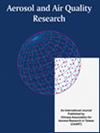巴基斯坦拉合尔公路沿线Alstonia Scholaris的空气污染耐受性及理化变化评估
IF 2.5
4区 环境科学与生态学
Q3 ENVIRONMENTAL SCIENCES
引用次数: 0
摘要
空气污染已成为全球一些国家严重的城市环境和健康问题。空气污染物还影响植物的生理、形态和生化过程,如气孔功能、光合作用、呼吸作用、叶面积、叶绿素含量、氨基酸、pH和植物生长。拉合尔是巴基斯坦第二大城市,面临着巨大的汽车尾气排放压力。本研究利用空气污染容忍水平和理化变化评价了拉合尔市最繁忙道路沿线的Alstonia scholaris生长的空气污染容忍潜力。测定了路边人工林的叶面积、抗坏血酸含量(AAC)、总叶绿素含量(TCh)、叶提取物pH、相对含水量(RWC)和叶片表面积尘量,并与对照植物(距离污染场地20 km)进行了比较。路边人工林下黄芪AAC、TCh含量、叶提取物pH和RWC平均值分别为0.0380 mg g -1、0.0537 mg g -1、5.94和68.3%。路边的叶面积尘量平均值0.381 mg mm -2,叶面积平均值1482 mm -2高于对照。路边人工林下黄麻APTI值(0.221)显著高于对照地(0.165)。综上所述,沿拉合尔污染道路的沙蚕对空气污染的耐受能力高于背景控制点。随着交通流量的增加,叶面积、AAC、TCh和APTI均呈下降趋势,表明交通流量对黄杨健康有影响。本文章由计算机程序翻译,如有差异,请以英文原文为准。
Assessment of Air Pollution Tolerance and Physicochemical Alterations of Alstonia Scholaris along Roadsides of Lahore, Pakistan
Air pollution has become a severe urban environmental and health problem in several countries around the globe. Air pollutants also affect the physiological, morphological and biochemical processes in plants such as stomatal function, photosynthesis, respiration, leaf area, chlorophyll content, amino acid, pH and plant growth. Lahore is the second largest city in Pakistan facing tremendous stress of vehicle emission. This study evaluated the air pollution tolerance potential of Alstonia scholaris growing along the busiest roads of Lahore city using air pollution tolerance level and physicochemical alterations. Leaf area, ascorbic acid content (AAC), total chlorophyll (TCh) content, leaf extract pH, relative water content (RWC), and dust accumulation on leaf surface were measured for the roadside plantation and compared with the control plants (at background sites, 20 km away from polluted sites). Average value of AAC, TCh content, leaf extract pH, and RWC of A. scholaris in the roadside plantation were, 0.0380 mg g –1 , 0.0537 mg g –1 , 5.94 and 68.3%, respectively. The average value of dust accumulation on the leaf surface 0.381 mg mm –2 and leaf area 1482 mm 2 were higher in roadside than control site. APTI value (0.221) observed for A. scholaris in the roadside plantation was significantly higher than that at the control site (0.165). It is concluded that the air pollution tolerance ability of A. scholaris was higher along the polluted roads of Lahore than in the background control site. Leaf area, AAC, TCh and APTI decrease as traffic flows increase, indicating that the health of A. scholaris was affected by traffic flow.
求助全文
通过发布文献求助,成功后即可免费获取论文全文。
去求助
来源期刊

Aerosol and Air Quality Research
ENVIRONMENTAL SCIENCES-
CiteScore
8.30
自引率
10.00%
发文量
163
审稿时长
3 months
期刊介绍:
The international journal of Aerosol and Air Quality Research (AAQR) covers all aspects of aerosol science and technology, atmospheric science and air quality related issues. It encompasses a multi-disciplinary field, including:
- Aerosol, air quality, atmospheric chemistry and global change;
- Air toxics (hazardous air pollutants (HAPs), persistent organic pollutants (POPs)) - Sources, control, transport and fate, human exposure;
- Nanoparticle and nanotechnology;
- Sources, combustion, thermal decomposition, emission, properties, behavior, formation, transport, deposition, measurement and analysis;
- Effects on the environments;
- Air quality and human health;
- Bioaerosols;
- Indoor air quality;
- Energy and air pollution;
- Pollution control technologies;
- Invention and improvement of sampling instruments and technologies;
- Optical/radiative properties and remote sensing;
- Carbon dioxide emission, capture, storage and utilization; novel methods for the reduction of carbon dioxide emission;
- Other topics related to aerosol and air quality.
 求助内容:
求助内容: 应助结果提醒方式:
应助结果提醒方式:


